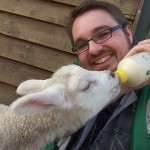
The concept of ‘therapeutic landscapes’ has been used by geographers as a way to critically understand how health and wellbeing are related to place. However, applications of the therapeutic landscape concept have often failed to discuss the heterogeneity of elements that come together to produce spaces of health and wellbeing. In order to more critically unpack the heterogeneity of ‘therapeutic spaces’ and engage with their more-than-human constitutive elements, I draw on post-structuralist understandings of space to demonstrate an approach which moves from considering places as inherently therapeutic, but rather instead describes how they emerge relationally co-constituted by a variety of heterogeneous agencies.
I mobilise qualitative research exploring animal-assisted-therapy and care-farming practices and spaces in England and Wales, to discuss how the agency and presence of animal life can often be crucial to the formation of specific therapeutic geographies and the opening up and closing down of therapeutic possibilities. I thus highlight the range of ways in which encounters with animals can shape and reshape people’s health assemblage, producing new bodily capacities, and allowing people to navigate and negotiate a range of difficult life situations. Further, I discuss how interactions with, and around, animals can lead to an increased desire to participate and engage in certain therapeutic processes, overcoming former barriers and perceptions, and actively creating and facilitating a therapeutic engagement with place.
However, when thinking about and discussing the role of animals within therapeutic practices and spaces, there is perhaps a need to ask, for whom exactly are these processes therapeutic? I thus also critically consider the ways in which animals become entangled in certain ‘therapeutic’ relationships with humans within these practices and spaces of care, exploring how care for humans and non-humans can be brought together and framed through more egalitarian relationships of mutualism.
Publications
Gorman, R. 2016. Changing ethnographic mediums: the place-based contingency of smartphones and scratchnotes. Area (doi:10.1111/area.12320) http://onlinelibrary.wiley.com/doi/10.1111/area.12320/full
Gorman, R. 2016. Therapeutic landscapes and non-human animals: the roles and contested positions of animals within care farming assemblages. Social & Cultural Geography (doi:10.1080/14649365.2016.1180424) http://www.tandfonline.com/doi/full/10.1080/14649365.2016.1180424

